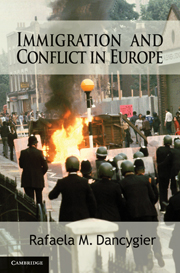Book contents
- Frontmatter
- Contents
- List of Figures and Tables
- Acknowledgments
- PART I GENERAL INTRODUCTION AND THEORETICAL FRAMEWORK
- PART II INTRODUCTION TO PART II
- 3 Patterns of Immigrant Conflict in Great Britain
- 4 Dynamics of Racist Violence
- PART III INTRODUCTION TO PART III
- PART IV INTRODUCTION TO PART IV
- 9 Conclusion
- Appendix A Coding Large-Scale Instances of Immigrant–Native and Immigrant–State Violence
- Appendix B Data and Variables: Immigrant Turnout
- References
- Index
- Titles in the series
3 - Patterns of Immigrant Conflict in Great Britain
Published online by Cambridge University Press: 17 November 2010
- Frontmatter
- Contents
- List of Figures and Tables
- Acknowledgments
- PART I GENERAL INTRODUCTION AND THEORETICAL FRAMEWORK
- PART II INTRODUCTION TO PART II
- 3 Patterns of Immigrant Conflict in Great Britain
- 4 Dynamics of Racist Violence
- PART III INTRODUCTION TO PART III
- PART IV INTRODUCTION TO PART IV
- 9 Conclusion
- Appendix A Coding Large-Scale Instances of Immigrant–Native and Immigrant–State Violence
- Appendix B Data and Variables: Immigrant Turnout
- References
- Index
- Titles in the series
Summary
Great Britain has witnessed large-scale violence involving first- and later-generation immigrants both as targets and as active participants in every decade since the 1950s. What accounts for this violence? In this chapter I present patterns of collective violence involving minorities of South Asian and West Indian descent and provide an explanation for its varied incidence across time, space, and groups.
I begin by cataloging major events of collective violence involving immigrant populations from 1950 until 2008 and classify them into two categories: episodes of immigrant–native conflict and instances of immigrant–state conflict. The most striking pattern that emerges from this compilation is the significant difference in involvement in such conflict across immigrant groups: Whereas immigrant–native violence has tended to occur between South Asians and whites but much less so between black Caribbeans and whites, immigrant–state violence has been associated with minorities originating from the Caribbean islands but to a much lesser degree with South Asians. Scholars studying immigration and race relations in Britain have surely not missed this difference. Nonetheless, as a result of a tendency to emphasize the common “black” (i.e., nonwhite) immigrant experience of racism, analytical distinctions between immigrant groups or conflict types, especially in the period covering the contentious 1970s and 1980s, are rare.
- Type
- Chapter
- Information
- Immigration and Conflict in Europe , pp. 62 - 101Publisher: Cambridge University PressPrint publication year: 2010

